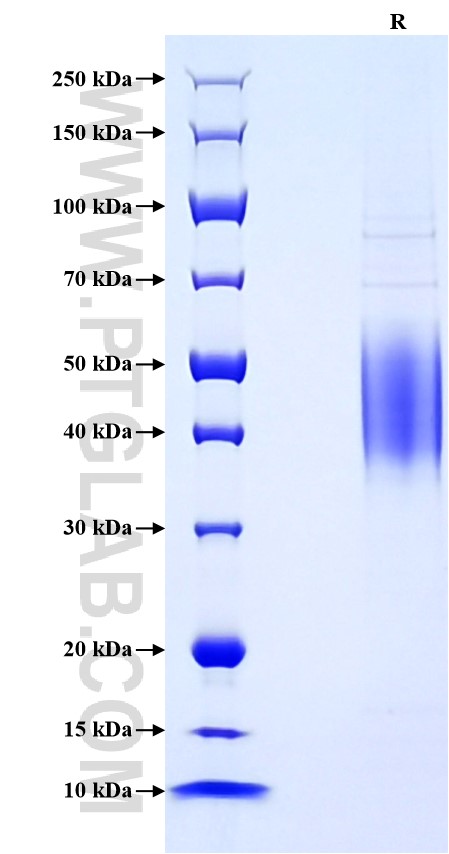Recombinant Mouse ICOSLG/B7-H2/CD275 protein (His Tag)
种属
Mouse
纯度
>90 %, SDS-PAGE
标签
His Tag
生物活性
未测试
验证数据展示
产品信息
| 纯度 | >90 %, SDS-PAGE |
| 内毒素 | <0.1 EU/μg protein, LAL method |
| 生物活性 | Not tested |
| 来源 | HEK293-derived Mouse ICOSLG protein Glu47-Lys279 (Accession# Q9JHJ8-1) with a His tag at the C-terminus. |
| 基因ID | 50723 |
| 蛋白编号 | Q9JHJ8-1 |
| 预测分子量 | 27.1 kDa |
| SDS-PAGE | 37-60 kDa, reducing (R) conditions |
| 组分 | Lyophilized from 0.22 μm filtered solution in PBS, pH 7.4. Normally 5% trehalose and 5% mannitol are added as protectants before lyophilization. |
| 复溶 | Briefly centrifuge the tube before opening. Reconstitute at 0.1-0.5 mg/mL in sterile water. |
| 储存条件 |
It is recommended that the protein be aliquoted for optimal storage. Avoid repeated freeze-thaw cycles.
|
| 运输条件 | The product is shipped at ambient temperature. Upon receipt, store it immediately at the recommended temperature. |
背景信息
ICOSLG, also known as B7-H2, CD275 or GL50, is a type I transmembrane glycoprotein belonging to the B7 ligand family. B7-H2/ICOSLG is extensively expressed on professional antigen-presenting cells including B cells, macrophages, and dendritic cells, as well as non-lymphoid cells including mesenchymal stem cells, endothelial cells, fibroblasts, and tumor cells. It is a specific ligand for the T-cell-specific cell surface receptor ICOS and acts as a co-stimulatory molecule. The interaction of B7-H2/ICOSLG and ICOS plays important roles in the activation, proliferation, differentiation, and cytokine production of T cells as well as in the antibody secretion from B cells during secondary immune responses.
参考文献:
1. S Wang, et al. (2000) Blood. 96(8):2808-13. 2. S K Yoshinaga, et al. (2000) Int Immunol. 12(10):1439-47. 3. Shuang Shen, et al. (2011) Hybridoma (Larchmt). 30(4):361-8. 4. Lucie Roussel, et al. (2021) Curr Opin Immunol. 72:21-26. 5. Marius Külp, et al. (2022) iScience. 25(7):104613.
